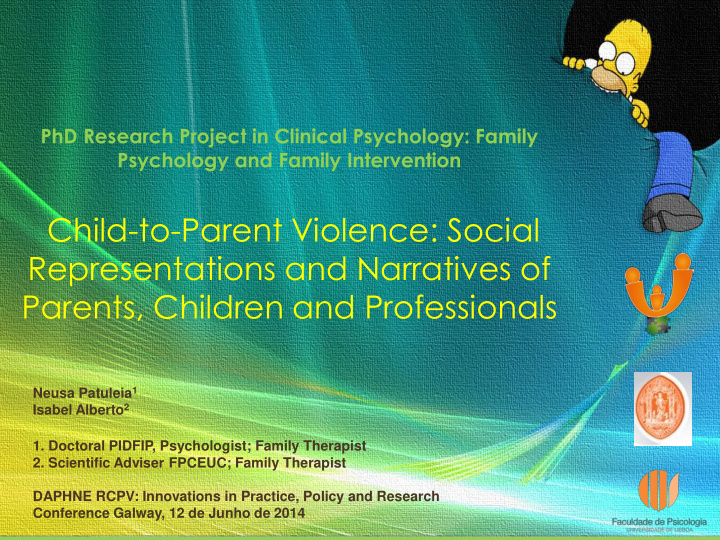



PhD Research Project in Clinical Psychology: Family Psychology and Family Intervention Child-to-Parent Violence: Social Representations and Narratives of Parents, Children and Professionals Neusa Patuleia 1 Isabel Alberto 2 1. Doctoral PIDFIP, Psychologist; Family Therapist 2. Scientific Adviser FPCEUC; Family Therapist DAPHNE RCPV: Innovations in Practice, Policy and Research Conference Galway, 12 de Junho de 2014
THEORETICAL FRAMEWORK The first references in the literature to Mistreated Parents Syndrome (Harbin & Madden, 1979) precede what Cottrell (2001) defined as the abuse of parents through an intentional act by a child, causing fear and physical harm, psychological or financial, whose goal is the acquisition of control and power over the parent, involving threats, intimidation and domination (Paterson, Luntz, Perlesz & Cotton, 2002).
VIII SNIP Aveiro 2013 This is what we now refer as Child-To-Parent Violence (CPV).
CPV as growing phenomenon According to Pereira and Bertino (2009), CPV has had a huge evolution and acquired global dimension in a single generation, with an incidence of 1% in French families, 4% in Japanese and 6% in the U.S. (Cyrulnik 2005), with an estimated prevalence of approximately 9.8% of CPV (in the form of physical abuse) in the general population (Álvarez, 2012).
CPV in Portugal Despite the significant increase (97.7%) of requests for assistance in cases of violence by children between 2004 and 2011 (Statistics APAV, 2012), empirical research around this issue is scarce.
However… Requests for assessment and intervention proliferate within the field of protection of youth with adolescents characterized as having a disruptive behavior: Youth at risk Absenteeism Outputs without permission Escapes Risk behaviors Becoming violent with ease Parents unable to impose limits Young people that need to be protected from the parental relationship and from themselves
CPV pattern? Subversion of the family hierarchy Misappropriation of power Lack of relational boundaries Symptom of a pathological relationship
Delayed recognition of CPV The widespread belief that parents have to protect their children and lack of clarity about what is an acceptable or unacceptable behavior have contributed to delay the recognition of CPV, even among professionals (Agnew & Huguley, 1989; Cornell & Gelles, 1982; Laurent & Derry, 1999).
Requirements of research There is no common reference around this problematic available to both professionals and families. In order to achieve an integrative understanding of this type of family violence, it is essential to promote greater social sensitivity to this type of violence and conduct further research on this phenomenon (Álvarez, 2012).
Main objective of this research To know the narratives of the protagonists and professionals on the factors that contribute to the emergence, maintenance and resolution of CPV If social representations and beliefs influence the construction of reality, to understand the phenomenon of CPV is essential, particularly to study the level of legitimacy of violence from children against their parents
Answering the questions: How does parents, children and professionals understand CPV? How does CPV emerge in the parent- children relationship, how is maintained and how to resolve/overcome it?
____________________________________ Project Outline Study 1: Qualitative Literature Review 4 Focus Groups featuring Narratives and Training profissionals CPV meaning Methodological psychosocial / judicial areas, scholars, security forces Sensibilização Procedures Sensitization Prevenção How Professional Prevention I ndividual Interviews It sets Experience Referencial parents and children diagnosed with It mantains CPV (12-21 years old) Common Comum de to overcome Understanding Entendimento Referential VFP CPV Study 2: Quantitative Tool Development: Intervenção + Earlier and atempada e eficaz Social more ões VFP Representations -socio-demographic effective featuring CPV inquiry Protocolo de 2 social Validation intervention -F actorial Analysis intervenção representation -2 scripts of semi scales structured Family interviews Reliability Intervention - Stability General - 2 social - Internal Consistency Population Protocol Social representation Representations scales without CPV neusapatuleia@gmail.com
Recommend
More recommend